Cite this document
(The Neighborhood in Tacoma, Washington Case Study, n.d.)
The Neighborhood in Tacoma, Washington Case Study. Retrieved from https://studentshare.org/social-science/1732546-neighborhood-report
The Neighborhood in Tacoma, Washington Case Study. Retrieved from https://studentshare.org/social-science/1732546-neighborhood-report
(The Neighborhood in Tacoma, Washington Case Study)
The Neighborhood in Tacoma, Washington Case Study. https://studentshare.org/social-science/1732546-neighborhood-report.
The Neighborhood in Tacoma, Washington Case Study. https://studentshare.org/social-science/1732546-neighborhood-report.
“The Neighborhood in Tacoma, Washington Case Study”, n.d. https://studentshare.org/social-science/1732546-neighborhood-report.


